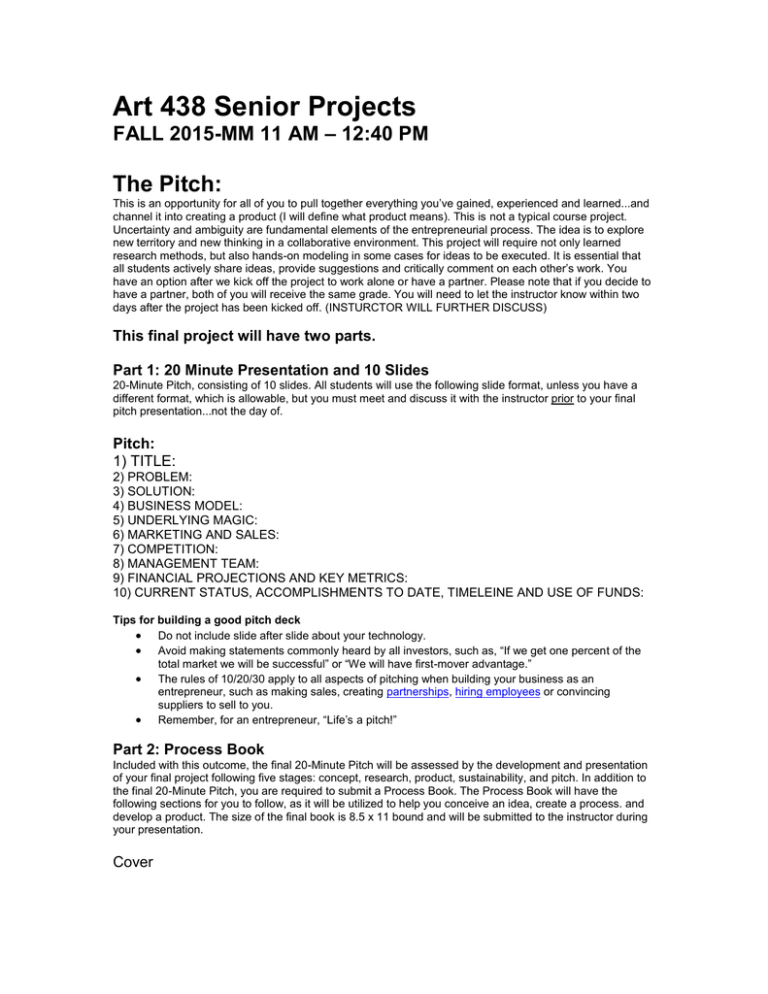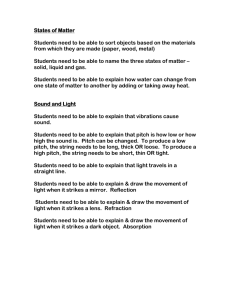ART 438 Document (DOC)
advertisement

Art 438 Senior Projects FALL 2015-MM 11 AM – 12:40 PM The Pitch: This is an opportunity for all of you to pull together everything you’ve gained, experienced and learned...and channel it into creating a product (I will define what product means). This is not a typical course project. Uncertainty and ambiguity are fundamental elements of the entrepreneurial process. The idea is to explore new territory and new thinking in a collaborative environment. This project will require not only learned research methods, but also hands-on modeling in some cases for ideas to be executed. It is essential that all students actively share ideas, provide suggestions and critically comment on each other’s work. You have an option after we kick off the project to work alone or have a partner. Please note that if you decide to have a partner, both of you will receive the same grade. You will need to let the instructor know within two days after the project has been kicked off. (INSTURCTOR WILL FURTHER DISCUSS) This final project will have two parts. Part 1: 20 Minute Presentation and 10 Slides 20-Minute Pitch, consisting of 10 slides. All students will use the following slide format, unless you have a different format, which is allowable, but you must meet and discuss it with the instructor prior to your final pitch presentation...not the day of. Pitch: 1) TITLE: 2) PROBLEM: 3) SOLUTION: 4) BUSINESS MODEL: 5) UNDERLYING MAGIC: 6) MARKETING AND SALES: 7) COMPETITION: 8) MANAGEMENT TEAM: 9) FINANCIAL PROJECTIONS AND KEY METRICS: 10) CURRENT STATUS, ACCOMPLISHMENTS TO DATE, TIMELEINE AND USE OF FUNDS: Tips for building a good pitch deck Do not include slide after slide about your technology. Avoid making statements commonly heard by all investors, such as, “If we get one percent of the total market we will be successful” or “We will have first-mover advantage.” The rules of 10/20/30 apply to all aspects of pitching when building your business as an entrepreneur, such as making sales, creating partnerships, hiring employees or convincing suppliers to sell to you. Remember, for an entrepreneur, “Life’s a pitch!” Part 2: Process Book Included with this outcome, the final 20-Minute Pitch will be assessed by the development and presentation of your final project following five stages: concept, research, product, sustainability, and pitch. In addition to the final 20-Minute Pitch, you are required to submit a Process Book. The Process Book will have the following sections for you to follow, as it will be utilized to help you conceive an idea, create a process. and develop a product. The size of the final book is 8.5 x 11 bound and will be submitted to the instructor during your presentation. Cover Content Summary Concept (Go deep and wide, add sketches, notes, etc. Be sure to model it or wireframe.) Market/Audience (Who will use this product?) Market Analysis and Competitor Analysis (Why will they use this product, and if there is a similar product, why will they choose your product?) Research (Again, go deep and wide and don’t forget to include sources.) Product (This is what you will produce...include product comparison. What will it look like?) Differentiation (Features and Benefits. Consider options that help differentiate.) Resources (What resources are required to build and sustain?) Risk (What are some potential risks associated with your product?) Sustainability (How will you maintain and sustain this product?) Management (Who will run and manage the product?) Marketing (How will people learn about your product?) Contact Information Back Cover Although, this is not something totally new, there were several sources and resources that were used to put together this project. I’m sure more sources will be associated with this project as we move forward, but the following sources helped to create the project, and I want to thank and acknowledge the work by these individuals and companies. Professor Jose Luis Benavides….Thank You! Guy Kawasaki on the “10/20/30 rule” https://www.youtube.com/watch?v=-M13SObffog The Art of the Start. David S. Rose on how to pitch to a VC http://www.ted.com/talks/david_s_rose_on_pitching_to_vcs Any TED Talks www.kickstarter.com References Kawasaki, G. (2004). The Art of the Start: The Time-Tested, Battle-Hardened Guide for Anyone Starting Anything. Toronto: Penguin Canada. Kawasaki, G. (2008). Reality Check: The Irreverent Guide to Outsmarting, Out managing, and Out marketing Your Competition. Toronto: Penguin Canada. Malcom Gladwell www.gladwell.com Neumeier, M (2003). The Brand Gap. New Riders Publishing. Berkeley California.




